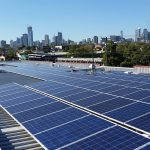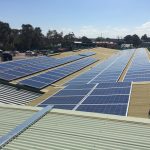In May 2016, we completed the installation of a 99kWp solar PV system on the iconic Brunswick Town Hall.
The hall is one of the 10 highest users of energy for Moreland City Council. Adding solar to the building would make a noticeable impact on the site. However the 140 year old building presenting some challenges:
- Access: The building is three storeys high and has steep 30 degree roof, requiring strict safety protocols, and limiting access to the site.
- Traffic: The building faces the busy, arterial Sydney road making delivery of equipment and hours of operation a challenge.
- Space: In addition to steepness, the part of the roof that was suitable for solar, had limited space for the panels. The roof is also shaded for part of the day.
With the expertise of our in-house team, our previous experience on complex solar projects and by working closely with the client, we overcame the hurdles and delivered an innovative solution.
Our in-house installer Nick Garric, describes the installation.
“Our installing team members had safety rails, were in safety harness for the four week installation period and because of the number of panels, we had to lay them in a landscape pattern, rather than the usual portrait configuration.
“This meant our roof access had to be up the 30 degree slope, rather than along the roof. Because of the age of the building and the roof, another difficulty we had to overcome was in running the cables from the panels to the inverter.”
A comprehensive safety and traffic management plan was developed and signed off that would allow for installation to happen during multiple times of the day and for equipment to be safely delivered to site.
Another challenge came in making the system ‘fit’ on the roof. To get to the required system size using traditional 260Wp panels would have required over 400 panels – which would not have fit on the roof.
The solution was to use 345 PERC Mono Trina Solar 290Wp panels. The higher efficiency and lower number of panels required meant that we could reach the goal without spreading the installation out over another part of the building – which would have resulted in longer installation times and more equipment.
Brunswick Town Hall will be the first site in Australia to use the 290Wp panels. And the cost difference wasn’t as high one would think.
“The rapid improvement in efficiency with mono modules coupled with the minimal price gap between the poly and the mono modules will soon see mono modules becoming main stream. The extra price on the mono modules is offset by the greater savings on the balance of the system,” said Govind Kant, Solar Sales Manager for Trina Solar.
Four Fronius inverters were used on the project: 2 x Fronius Eco inverters and 2 x Fronius Symo inverters.
With all the challenges, the installation was still completed in 20 days – on time, on schedule and on budget.
Stuart Nesbit from Moreland City Council said of the project:
“Envirogroup were selected following a public tender process to deliver a 100kW Solar PV system at the historically iconic Brunswick Town Hall for Moreland City Council. They were successful in their bid based on a number of factors including the quality of their submission, products offered that met Councils higher standards, and the proposed layout of the panels on the main library roof which was important to Moreland being a heritage building.
The installation has stimulated interest from the community and surrounding businesses as its highly visible to passers-by and makes a statement as to Moreland’s environmental credentials.
The system has been performing well since installation and is on target to meeting the environmental benefits and return on investment calculations that underpinned the project. We’re very happy with the project outcomes and the way in which Envirogroup delivered the project”








